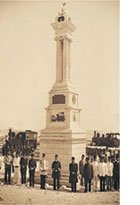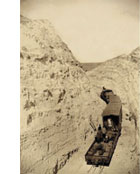The Railway of
Faith
100th Anniversary of the Hejaz
Railway
 The Hejaz Railway is the
Train of Faith, built between 1901 and 1908 thanks to donations
from Moslem believers and designed to carry pilgrims to the holy
cities of Mecca and Medina.
The Hejaz Railway is the
Train of Faith, built between 1901 and 1908 thanks to donations
from Moslem believers and designed to carry pilgrims to the holy
cities of Mecca and Medina.
On May 2, 1900, Turkish Sultan Abdul Hamid II, ruler of the Ottoman
Empire, declared his wish to build a railway that would enable
Moslem pilgrims in Damascus, Syria, to reach the Islamic holy
cities of Mecca and Medina. The railway would run through the Hijaz
in the Arabian Peninsula. The sultan intended the railway's
construction to be financed exclusively by Islamic sources, unlike
other railways built by the Ottoman Empire which were funded by
European companies. The cost of the railway was approximately four
million pounds sterling, which was contributed by the sultan, the
rulers of Egypt and Iran, Morocco and Bukhara, as well as numerous
Moslem believers throughout the world.
It was an unprecedented engineering and economic feat, unlike any
other in the history of the empire. The railway from Damascus to
Medina was
completed on September 1, 1908, the 33rd anniversary of the
sultan's accession to the throne. Traveling time was approximately 72 hours in
comparison to the many weeks it took by camel caravan.
approximately 72 hours in
comparison to the many weeks it took by camel caravan.
The sultan's aspiration to continue the construction of the
railway, which would eventually reach Mecca, never materialized. In
1909 Abdul Hamid II was deposed by the revolution of the Young
Turks and with his fall the construction of the railway came to an
end. In addition to its religious designation, the Train of Belief
served the Ottoman regime for transporting military forces to the
Medina region. During World War I the railway was damaged several
times by the Arab rebels who fought against the Turks under
Lawrence of Arabia, thus serving British strategic interests.
The Hejaz Railway had a branch line that passed through the Land of
Israel and connected Haifa to the Syrian town of Dara. In the
Jewish yishuv it was known as Rakevet Ha'emek, the Valley Train.
This branch line greatly contributed to the development of the city
of Haifa and the Jewish localities in the Jezreel Valley. The
Valley Train came to an end in 1948 during Israel's War of
Independence,
but it has remained in the collective memory of the yishuv as a
visual icon and a source for poetry and fiction.
The exhibit presents a collection of photographs and postcards from
the time the railway was built, which are juxtaposed with
contemporary photographs of the same sites, sections of the
railway, original maps, films and rare philatelic items taken from
the Alexander Collection, such as letters that were sent via the
Hejaz Railway and stamped in the carriage that provided postal
services to the travelers.
The exhibit is under the auspices of the Turkish Embassy in
Israel.
 Turkish 20 para Postcard sent from
El-Ula to Koln in Germany. Cancelled by the special commemorative
seal "EL ULA MEVKIFI POSTA SHBESI HATTI ALI (19) AGUSTOS 323" (EL
ULA STATION BRANCH POST OFFICE AUGUST 1907). Addressed to the
editorial office of the "Koln Zeitung" & reads: "From today's
inauguration of the railway to El-Ula (Km. 980) I am sending you my
best regards, on a postcard postmarked with the special postmark"
signed "your old friend J. Meisner".
Turkish 20 para Postcard sent from
El-Ula to Koln in Germany. Cancelled by the special commemorative
seal "EL ULA MEVKIFI POSTA SHBESI HATTI ALI (19) AGUSTOS 323" (EL
ULA STATION BRANCH POST OFFICE AUGUST 1907). Addressed to the
editorial office of the "Koln Zeitung" & reads: "From today's
inauguration of the railway to El-Ula (Km. 980) I am sending you my
best regards, on a postcard postmarked with the special postmark"
signed "your old friend J. Meisner".
Curator: Sarah Turel
Closes: December 31, 2009